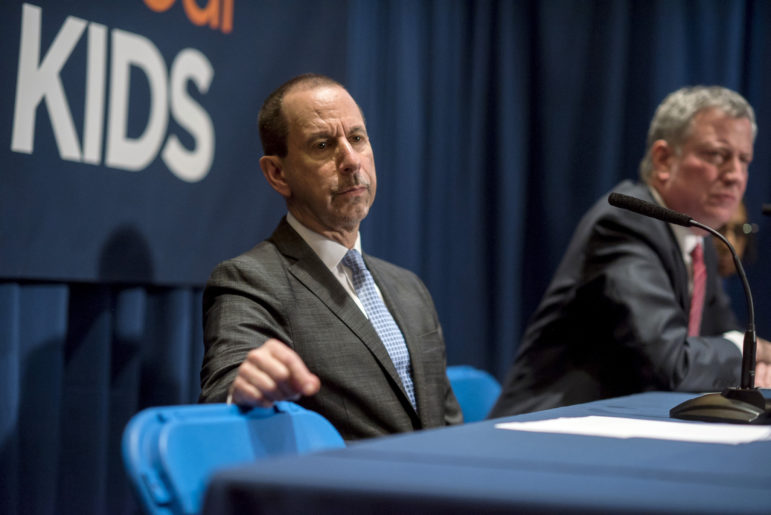‘Four out of five families who enroll in prevention programs complete them. And, once they complete services, these families are five times less likely to experience another report of abuse and/or neglect in the near term. Prevention services have also helped to safely reduce our utilization of foster care. Currently, there are less than 8,000 children in foster care, down from over twice that much a decade ago.’

Ed Reed/Mayoral Photography Office
The author, ACS Commissioner David A. Hansell, at a pre-pandemic announcement with Mayor Bill de Blasio.The best way to keep children safe is to provide support to families who need a helping hand—something the NYC Administration for Children’s Services (ACS) and our contracted provider agencies do through a range of prevention programs aimed at meeting each families’ individual needs. As we recognize April as National Child Abuse Prevention Month, we are reminded that, now more than ever, families are under an unusual amount of stress due to the COVID-19 pandemic and that prevention services have been and continue to prove crucial.
Prevention services provide families with the help they need to overcome challenges— including trauma, poverty, isolation, mental health, substance mis-use and domestic violence—and ultimately keep children safe. In the vast majority of child welfare investigations where ACS identifies a concern, families are able to engage in prevention services, including homemaking services, mental health counseling, substance abuse treatment and more. Our contracted provider agencies are also expected to plan for families’ concrete needs, including food, housing and medical care. All of these services and resources have continued throughout the pandemic and, even more so, served as a critical support to families during what has been an incredibly challenging time.
We know that New York City’s prevention services system is working. We have found that four out of five families who enroll in prevention programs complete them. And, once they complete services, these families are five times less likely to experience another report of abuse and/or neglect in the near term. Prevention services have also helped to safely reduce our utilization of foster care. Currently, there are less than 8,000 children in foster care, down from over twice that much a decade ago.
 CityViews are readers’ opinions, not those of City Limits. Add your voice today!
CityViews are readers’ opinions, not those of City Limits. Add your voice today!
Not only do our numbers indicate prevention services are working, but families are telling us themselves. In 2019, ACS issued the results of our first-ever survey of families receiving prevention services. The survey results overwhelmingly showed families believe the services have helped to strengthen their parenting. Approximately 94 percent of survey respondents said they were happy with the prevention services their families received and 71 percent of respondents said they would recommend these services to a family or family member.
We are also committed to providing “primary” prevention services, which are aimed at getting families the support they need completely independent of the traditional child welfare system, and with the goal of avoiding any involvement with that system. For instance, in 2017, we piloted our first Family Enrichment Center in a neighborhood with high child welfare involvement. Fast forward to today and we now have three FECs located in East New York, Brooklyn; Highbridge, Bronx; and Hunts Point/Longwood, Bronx.
What makes these Centers unique is that they are co-created with families and community members so that they truly represent responses to community-identified needs. They are open-door, walk-in facilities, with no connection to other child welfare services. During the COVID-19 pandemic, FECs sought to meet families’ critical needs, including technology/hotspots to assist children with virtual learning; LYFT car credits so community members could pick up food, medication and commute to doctor visits; and food, laundry cards and detergent.
Another critical component of this work includes our Community Partnership Programs (CPPs). We know that many of our neighborhoods are rich in services and resources, but they are often poorly connected and difficult for families to access. In 11 high-need neighborhoods around the City, CPPs leverage existing services by creating two-generation continuums of care in each community. The partnerships help to connect the service dots, so that families are aware of, and can better access, the full continuum of supports in their neighborhoods.
In the last year, the pandemic has underscored what we already knew: that often what families need most is concrete support and services, to address poverty and its related impacts. That highlights the importance of continuing to focus on a full spectrum of prevention services, providing what families need when they need it. That’s been our approach in New York City and will continue to be our approach moving forward.









One thought on “Opinion: Child Abuse Prevention Services Have Proved Crucial During the COVID-19 Pandemic”
Another infomercial from another commissioner who paints a glossy picture of an abysmal, oppressive bureaucracy. I led a contracted provider agency for many years and encountered a dysfunctional bureaucracy purported to protect NYC’s vulnerable children, yet child abuse and deaths continue unabated. This reality remains. ACS and child welfare systems nationally have historically served as another layer of oppression upon poor and working class, predominantly BIPOC communities. They have served as appendages of the carceral state, which is an essential feature of American public policy toward eliminating dissent that would endanger American plutocracy. We must resist…